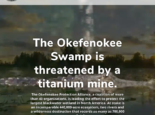Defending the Georgia coast
Preserving one of the nation’s ecological gems
Admired around the world for its stunning beauty and rich biological diversity, the Georgia coast encompasses a lacework of barrier islands, mud flats, tidal creeks, blackwater rivers, freshwater wetlands, and 378,000 acres of salt marsh. More than 1,650 islands called marsh hammocks provide a secluded inland sanctuary for wildlife. These enclaves are sheltered by 14 barrier islands lined with more than 100 miles of white sandy beaches.
Georgia harbors one-third of the salt marsh remaining on the East Coast, most of which is held by the state as a public resource with incalculable value. These vast expanses of grasses and meandering tidal creeks serve as nurseries for marine life and as vital buffers against storms.
In addition, the ocean waters off the Georgia coast are prime calving grounds for the North Atlantic right whale — one of the rarest marine mammals on the planet and one of several endangered and threatened species that make their home in this region, along with manatees, wood storks, and sea turtles.
What’s at stake
Though it remains one of the last stretches of undeveloped coastline in the South, this special region faces a perfect storm of ongoing industrial and residential development pressures. With the continued expansion of the Savannah Harbor and construction of major manufacturing facilities under construction and more on the horizon, the population of Savannah — and its neighboring counties — is on the verge of a tipping point. The environmental laws in place fail to address the needs of both businesses and residents.
To this end, we are working with our partners to enact more stringent safeguards for Georgia’s coastal waterways, including buffer protections for marshlands, freshwater wetlands, and all other state waters not currently protected.
We continue to build more awareness and celebration of our coastal resources, embolden citizen participation in community conservation, and encourage state leaders to take action to ensure that the coast is protected for present and future generations.
Georgia’s coast must continue to be a safe place for both our ships and our wildlife. We are committed to ensuring that our harbors are responsibly maintained and that our beloved wildlife, like loggerhead sea turtles and North Atlantic right whales, are protected.
Megan Desrosiers, president and CEO of One Hundred Miles
Twin Pines mine not worth the risk
Threats to Georgia’s coastal treasures
Alongside local partners, federal and state agencies, and private property owners, we advocate against poorly-sited projects and loopholes favoring development interests in efforts to preserve the ecological and natural integrity of Georgia’s coastline and iconic barrier islands. Included in this work are our recent efforts to make coastal communities more resilient to the ravages of climate change so the coast’s most vulnerable residents are better protected from flooding, storm surge, and storm damage.
The latest in a string of emerging threats to the Georgia coast’s natural treasures, Alabama-based mining company Twin Pines is proposing a heavy mineral sand strip mine on the doorstep of the Okefenokee Swamp, one of the largest and most celebrated wetlands in the country and home to both a National Wildlife Refuge and a National Wilderness Area.
The proposed mine would destroy hundreds of acres of wetlands adjacent to the Okefenokee and threaten the hydrology of the swamp. With plans to dig deep into the sandy ridge confining the Okefenokee, the Twin Pines mining operation could cause the water levels in swamp to decrease significantly. We staunchly oppose any mining activities at this site and will continue working to protect the integrity of the swamp, especially now that the Okefenokee is under consideration for UNESCO World Heritage status and an immersive educational center called the Okefenokee Experience.
We push back against proposals that pose serious risks to coastal resources, surrounding communities, tourism and other local economies — including a commercial spaceport in Camden County that would launch rockets over residential areas and the Cumberland Island National Seashore. In May 2022, we filed a lawsuit challenging the Federal Aviation Administration’s decision to issue an operating license for the risky plan.
Our coastal protection work also includes challenging the U.S. Army Corps of Engineers’ unlawful attempts to allow coastal harbor dredging projects to go forward during the summer months which would put in harm’s way threatened and endangered sea turtles and other marine life.
Additional Resources

